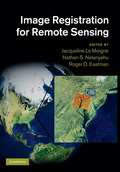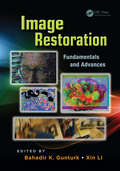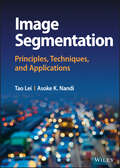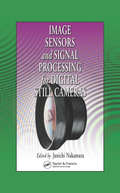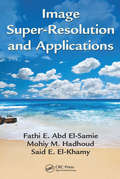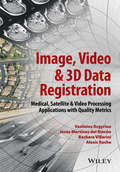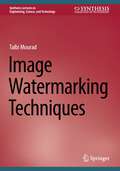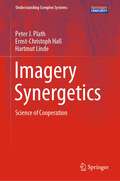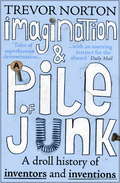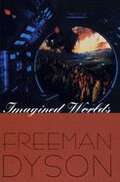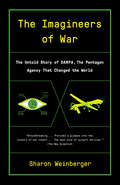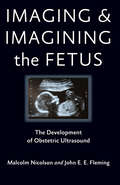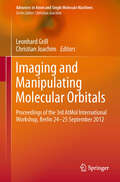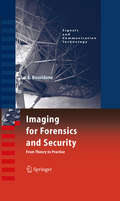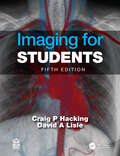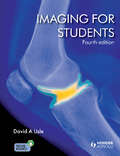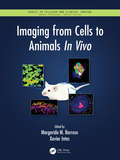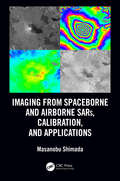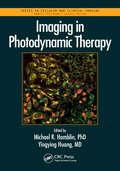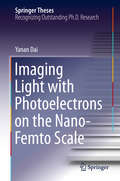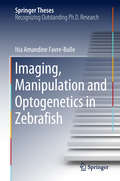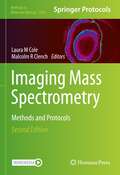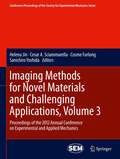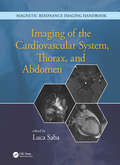- Table View
- List View
Image Registration for Remote Sensing
by Nathan S. Netanyahu Jacqueline Le Moigne Roger D. EastmanImage registration employs digital image processing in order to bring two or more digital images into precise alignment for analysis and comparison. Accurate registration algorithms are essential for creating mosaics of satellite images and tracking changes on the planet's surface over time. Bringing together invited contributions from 36 distinguished researchers, the book presents a detailed overview of current research and practice in the application of image registration to remote sensing imagery. Chapters cover the problem definition, theoretical issues in accuracy and efficiency, fundamental algorithms, and real-world case studies of image registration software applied to imagery from operational satellite systems. This book provides a comprehensive and practical overview for Earth and space scientists, presents image processing researchers with a summary of current research, and can be used for specialised graduate courses.
Image Restoration: Fundamentals and Advances (Digital Imaging and Computer Vision #7)
by Xin Li Bahadir K. GunturkImage Restoration: Fundamentals and Advances responds to the need to update most existing references on the subject, many of which were published decades ago. Providing a broad overview of image restoration, this book explores breakthroughs in related algorithm development and their role in supporting real-world applications associated with various scientific and engineering fields. These include astronomical imaging, photo editing, and medical imaging, to name just a few. The book examines how such advances can also lead to novel insights into the fundamental properties of image sources. Addressing the many advances in imaging, computing, and communications technologies, this reference strikes just the right balance of coverage between core fundamental principles and the latest developments in this area. Its content was designed based on the idea that the reproducibility of published works on algorithms makes it easier for researchers to build on each other’s work, which often benefits the vitality of the technical community as a whole. For that reason, this book is as experimentally reproducible as possible. Topics covered include: Image denoising and deblurring Different image restoration methods and recent advances such as nonlocality and sparsity Blind restoration under space-varying blur Super-resolution restoration Learning-based methods Multi-spectral and color image restoration New possibilities using hybrid imaging systems Many existing references are scattered throughout the literature, and there is a significant gap between the cutting edge in image restoration and what we can learn from standard image processing textbooks. To fill that need but avoid a rehash of the many fine existing books on this subject, this reference focuses on algorithms rather than theories or applications. Giving readers access to a large amount of downloadable source code, the book illustrates fundamental techniques, key ideas developed over the years, and the state of the art in image restoration. It is a valuable resource for readers at all levels of understanding.
Image Segmentation: Principles, Techniques, and Applications
by Tao Lei Asoke K. NandiImage Segmentation Summarizes and improves new theory, methods, and applications of current image segmentation approaches, written by leaders in the field The process of image segmentation divides an image into different regions based on the characteristics of pixels, resulting in a simplified image that can be more efficiently analyzed. Image segmentation has wide applications in numerous fields ranging from industry detection and bio-medicine to intelligent transportation and architecture. Image Segmentation: Principles, Techniques, and Applications is an up-to-date collection of recent techniques and methods devoted to the field of computer vision. Covering fundamental concepts, new theories and approaches, and a variety of practical applications including medical imaging, remote sensing, fuzzy clustering, and watershed transform. In-depth chapters present innovative methods developed by the authors—such as convolutional neural networks, graph convolutional networks, deformable convolution, and model compression—to assist graduate students and researchers apply and improve image segmentation in their work. Describes basic principles of image segmentation and related mathematical methods such as clustering, neural networks, and mathematical morphology. Introduces new methods for achieving rapid and accurate image segmentation based on classic image processing and machine learning theory. Presents techniques for improved convolutional neural networks for scene segmentation, object recognition, and change detection, etc. Highlights the effect of image segmentation in various application scenarios such as traffic image analysis, medical image analysis, remote sensing applications, and material analysis, etc. Image Segmentation: Principles, Techniques, and Applications is an essential resource for undergraduate and graduate courses such as image and video processing, computer vision, and digital signal processing, as well as researchers working in computer vision and image analysis looking to improve their techniques and methods.
Image Sensors and Signal Processing for Digital Still Cameras (Optical Science and Engineering)
by Junichi NakamuraShrinking pixel sizes along with improvements in image sensors, optics, and electronics have elevated DSCs to levels of performance that match, and have the potential to surpass, that of silver-halide film cameras. Image Sensors and Signal Processing for Digital Still Cameras captures the current state of DSC image acquisition and signal processing technology and takes an all-inclusive look at the field, from the history of DSCs to future possibilities.The first chapter outlines the evolution of DSCs, their basic structure, and their major application classes. The next few chapters discuss high-quality optics that meet the requirements of better image sensors, the basic functions and performance parameters of image sensors, and detailed discussions of both CCD and CMOS image sensors. The book then discusses how color theory affects the uses of DSCs, presents basic image processing and camera control algorithms and examples of advanced image processing algorithms, explores the architecture and required performance of signal processing engines, and explains how to evaluate image quality for each component described. The book closes with a look at future technologies and the challenges that must be overcome to realize them.With contributions from many active DSC experts, Image Sensors and Image Processing for Digital Still Cameras offers unparalleled real-world coverage and opens wide the door for future innovation.
Image Super-Resolution and Applications
by Fathi E. El-Samie Mohiy M. Hadhoud Said E. El-KhamyThis book is devoted to the issue of image super-resolution-obtaining high-resolution images from single or multiple low-resolution images. Although there are numerous algorithms available for image interpolation and super-resolution, there's been a need for a book that establishes a common thread between the two processes. Filling this need, Image
Image, Video and 3D Data Registration
by Jesus Martinez Del Rincon Barbara Villarini Vasileios Argyriou Alexis RocheData registration refers to a series of techniques for matching or bringing similar objects or datasets together into alignment. These techniques enjoy widespread use in a diverse variety of applications, such as video coding, tracking, object and face detection and recognition, surveillance and satellite imaging, medical image analysis and structure from motion. Registration methods are as numerous as their manifold uses, from pixel level and block or feature based methods to Fourier domain methods. This book is focused on providing algorithms and image and video techniques for registration and quality performance metrics. The authors provide various assessment metrics for measuring registration quality alongside analyses of registration techniques, introducing and explaining both familiar and state-of-the-art registration methodologies used in a variety of targeted applications.Key features: Provides a state-of-the-art review of image and video registration techniques, allowing readers to develop an understanding of how well the techniques perform by using specific quality assessment criteria Addresses a range of applications from familiar image and video processing domains to satellite and medical imaging among others, enabling readers to discover novel methodologies with utility in their own research Discusses quality evaluation metrics for each application domain with an interdisciplinary approach from different research perspectives
Image Watermarking Techniques (Synthesis Lectures on Engineering, Science, and Technology)
by Talbi MouradThis book investigates the image watermarking domain, analyzing and comparing image watermarking techniques that exist in current literature. The author’s goal is to aid researchers and students in their studies in the vast and important domain of image watermarking, including its advantages and risks. The book has three chapters: image watermarking using data compression; speech modulation for image watermarking; and secure image watermarking based on LWT and SVD.In addition, this book: Investigates the image watermarking domain, analyzing and comparing current image watermarking techniquesIncludes detail on image encryption and mathematical tools used for image watermarkingCovers image watermarking using data compression, speech modulation for image watermarking, and more
Imagery Synergetics: Science of Cooperation (Understanding Complex Systems)
by Peter J. Plath Ernst-Christoph Haß Hartmut LindeThis text will be replaced by the correThis book is aimed to a broad audience of researchers and students who are interested in questions of structure formation in complex systems in nature and society. When we think of synergetics, impressive images of complex structures immediately come to mind. Such images serve us as starting point and guide for understanding structure formation in chemical, biological, physical, geological, and social systems.Many fascinating pictures of new experimental results illustrate the imagery of synergetics and at the same time enable precise statements about the underlying laws based on precise and discussed measurements. In this way, for example, the famous Runge pictures are accessible to a physico-chemical description, and it turns out that the well-known disintegration of the beer foam satisfies a consecutive kinetics with feedback. The modeling by means of cellular automata and iterated function systems enables us to study the cooperative character of pattern formation on sea shells on the one hand but also to show that creativity is a cooperative effect.ct back cover text / information text as soon as we get it.
Imagination and a Pile of Junk: A Droll History of Inventors and Inventions
by Trevor Norton'In his whistle-stop tour of inventions large and small, the scientist Trevor Norton shares the Gershwins' view that invention is fundamentally comic.' The Sunday TimesTrevor Norton, who has been compared to Gerard Durrell and Bill Bryson, weaves an entertaining history with a seductive mix of eureka moments, disasters and dirty tricks. Although inventors were often scientists or engineers, many were not: Samuel Morse (Morse code) was a painter, Lazlow Biro (ballpoint) was a sculptor and hypnotist, and Logie Baird (TV) sold boot polish. The inventor of the automatic telephone switchboard was an undertaker who believed the operator was diverting his calls to rival morticians so he decided to make all telephone operators redundant. Inventors are mavericks indifferent to conventional wisdom so critics were dismissive of even their best ideas: radio had 'no future,' electric light was 'an idiotic idea' and X-rays were 'a hoax.' Even so, the state of New Jersey moved to ban X-ray opera glasses. The head of the General Post Office rejected telephones as unneccesary as there were 'plenty of small boys to run messages.'Inventomania is a magical place where eccentrics are always in season and their stories are usually unbelievable - but rest assured, nothing has been invented.
Imagination and a Pile of Junk: A Droll History of Inventors and Inventions
by Trevor Norton'In his whistle-stop tour of inventions large and small, the scientist Trevor Norton shares the Gershwins' view that invention is fundamentally comic.' The Sunday TimesTrevor Norton, who has been compared to Gerard Durrell and Bill Bryson, weaves an entertaining history with a seductive mix of eureka moments, disasters and dirty tricks. Although inventors were often scientists or engineers, many were not: Samuel Morse (Morse code) was a painter, Lazlow Biro (ballpoint) was a sculptor and hypnotist, and Logie Baird (TV) sold boot polish. The inventor of the automatic telephone switchboard was an undertaker who believed the operator was diverting his calls to rival morticians so he decided to make all telephone operators redundant. Inventors are mavericks indifferent to conventional wisdom so critics were dismissive of even their best ideas: radio had 'no future,' electric light was 'an idiotic idea' and X-rays were 'a hoax.' Even so, the state of New Jersey moved to ban X-ray opera glasses. The head of the General Post Office rejected telephones as unneccesary as there were 'plenty of small boys to run messages.'Inventomania is a magical place where eccentrics are always in season and their stories are usually unbelievable - but rest assured, nothing has been invented.
Imagined Worlds (Jerusalem-Harvard Lectures)
by Freeman DysonImagine a world where whole eons will pass, cultures rise and fall, between a telephone call and its reply. Think of the human race multiplying 500-millionfold or evolving new, unique species. Consider the technology of space colonization, computer-assisted reproduction, the "Martian potato." One hundred years after H. G. Wells visited the future in "The Time Machine," Freeman Dyson marshals his uncommon gifts as a scientist and storyteller to take us once more to such worlds, which may or may not be in our future.
The Imagineers of War: The Untold Story of DARPA, the Pentagon Agency That Changed the World
by Sharon WeinbergerThe definitive history of the Defense Advanced Research Projects Agency, the Pentagon agency that has quietly shaped war and technology for nearly sixty years.Founded in 1958 in response to the launch of Sputnik, the agency’s original mission was to create “the unimagined weapons of the future.” Over the decades, DARPA has been responsible for countless inventions and technologies that extend well beyond military technology. Sharon Weinberger gives us a riveting account of DARPA’s successes and failures, its remarkable innovations, and its wild-eyed schemes. We see how the threat of nuclear Armageddon sparked investment in computer networking, leading to the Internet, as well as to a proposal to power a missile-destroying particle beam by draining the Great Lakes. We learn how DARPA was responsible during the Vietnam War for both Agent Orange and the development of the world’s first armed drones, and how after 9/11 the agency sparked a national controversy over surveillance with its data-mining research. And we see how DARPA’s success with self-driving cars was followed by disappointing contributions to the Afghanistan and Iraq wars.Weinberger has interviewed more than one hundred former Pentagon officials and scientists involved in DARPA’s projects—many of whom have never spoken publicly about their work with the agency—and pored over countless declassified records from archives around the country, documents obtained under the Freedom of Information Act, and exclusive materials provided by sources. The Imagineers of War is a compelling and groundbreaking history in which science, technology, and politics collide.
Imaging and Imagining the Fetus: The Development of Obstetric Ultrasound
by Malcolm Nicolson John E. FlemingHow engineers and clinicians developed the ultrasound diagnostic scanner and how its use in obstetrics became controversial.To its proponents, the ultrasound scanner is a safe, reliable, and indispensable aid to diagnosis. Its detractors, on the other hand, argue that its development and use are driven by the technological enthusiasms of doctors and engineers (and the commercial interests of manufacturers) and not by concern to improve the clinical care of women. In some U.S. states, an ultrasound scan is now required by legislation before a woman can obtain an abortion, adding a new dimension to an already controversial practice. Imaging and Imagining the Fetus engages both the development of a modern medical technology and the concerted critique of that technology.Malcolm Nicolson and John Fleming relate the technical and social history of ultrasound imaging—from early experiments in Glasgow in 1956 through wide deployment in the British hospital system by 1975 to its ubiquitous use in maternity clinics throughout the developed world by the end of the twentieth century. Obstetrician Ian Donald and engineer Tom Brown created ultrasound technology in Glasgow, where their prototypes were based on the industrial flaw detector, an instrument readily available to them in the shipbuilding city. As a physician, Donald supported the use of ultrasound for clinical purposes, and as a devout High Anglican he imbued the images with moral significance. He opposed abortion—decisions about which were increasingly guided by the ultrasound technology he pioneered—and he occasionally used ultrasound images to convince pregnant women not to abort the fetuses they could now see.Imaging and Imagining the Fetus explores why earlier innovators failed where Donald and Brown succeeded. It also shows how ultrasound developed into a "black box" technology whose users can fully appreciate the images they produce but do not, and have no need to, understand the technology, any more than do users of computers. These "images of the fetus may be produced by machines," the authors write, "but they live vividly in the human imagination."
Imaging and Manipulating Molecular Orbitals: Proceedings of the 3rd AtMol International Workshop, Berlin 24-25 September 2012
by Christian Joachim Leonard GrillImaging and Manipulating Molecular Orbitals celebrates the 60th anniversary of the first image of a single molecule by E. Müller. This book summarizes the advances in the field from various groups around the world who use a broad range of experimental techniques: scanning probe microscopy (STM and AFM), field emission microscopy, transmission electron microscopy, attosecond tomography and photoemission spectroscopy. The book is aimed at those who are interested in the field of molecular orbital imaging and manipulation. Included in the book are a variety of experimental techniques in combination with theoretical approaches which describe the spatial distribution and energies of the molecular orbitals. The goal is to provide the reader with an up-to-date summary on the latest developments in this field from various points of view.
Imaging for Forensics and Security
by Ahmed BouridaneImaging for Forensics and Security: From Theory to Practice provides a detailed analysis of new imaging and pattern recognition techniques for the understanding and deployment of biometrics and forensic techniques as practical solutions to increase security. It contains a collection of the recent advances in the technology ranging from theory, design, and implementation to performance evaluation of biometric and forensic systems. This book also contains new methods such as the multiscale approach, directional filter bank, and wavelet maxima for the development of practical solutions to biometric problems. The book introduces a new forensic system based on shoeprint imagery with advanced techniques for use in forensics applications. It also presents the concept of protecting the originality of biometric images stored in databases against intentional and unintentional attacks and fraud detection data in order to further increase the security.
Imaging for Students
by Craig Hacking David Lisle'I would have found this book invaluable at medical school, but as a now qualified GP I think it is a fabulous resource. The fact it covers so much is remarkable … It is so comprehensive – great images, well explained.' Donna Pilkington, GP with an interest in medical education, Northern Ireland, UK 'It is direct and succinct. Just what you need in a portable book that aims to give you the essentials [it does] a great job of incorporating a huge amount of information covering the wide range of radiology examinations and procedures into a readable and practical book for students. A good introduction for year 1 radiology residents too.' Dr Mike Hurrell, Clinical Senior Lecturer and Consultant Radiologist, University of Otago, Christchurch, New Zealand 'The text works very well for the Medical Imaging Students – providing an overview of each modality and key insights into the clinical question to be resolved … the information is presented in an accessible fashion and well-illustrated.' Associate Professor Debbie Starkey, Discipline Leader, Medical Radiation Sciences, School of Clinical Sciences, Faculty of Health, Queensland University of Technology, Brisbane, Australia Imaging for Students delivers step-by-step guidance to the range of imaging techniques available, providing a clear explanation of how each imaging modality actually works, and including information on the associated risks and hazards. Throughout, the importance of patient preparation and post-procedure observation is emphasized. Taking information from evidence-based studies and published guidelines, in line with current clinical practice, the book takes a highly logical approach to the investigation of clinical scenarios, where possible indicating the 'best first test'—vital to both appropriate clinical and cost-effective decision-making. Key Features: Readable and concise – focusing on the common diseases that medical students most frequently encounterFully revised and updated – including up-to-date information on the latest imaging techniques including spectral CT, liver elastography, new and emerging PET techniques, multiparametric imaging and the role of AIHeavily illustrated - over 450 high-quality photographs, many new to this edition including colour images, are essential to support this visual subjectHighly structured and accessible format – plentiful use of tables and lists, and introduction of new summary boxes, all ideal for study and exam preparationCompanion website – image library including normal anatomy, clinical cases and MCQs for self-assessment, RADS reporting systems and detailed staging systems for common tumours relevant to each section; visit www.routledge.com/cw/hacking Drawing on the extensive clinical and teaching experience of its respected author team, the fifth edition of Imaging for Students gives students and junior doctors everything they need to understand the advantages, disadvantages, and possible side effects of the imaging modalities available, and how to apply them appropriately in clinical practice. The Authors: Craig Hacking is an Associate Professor of Radiology and Academic Lead for Clinical Radiology, University of Queensland Medical School and a Consultant Radiologist and the Medical Director of Medical Imaging at the Royal Brisbane and Women’s Hospital, Brisbane, Australia. David Lisle is an Associate Professor of Medical Imaging, University of Queensland Medical School, a Consultant Radiologist at Brisbane Private Hospital, Brisbane, Australia, an examiner for the Royal Australian and New Zealand College of Radiologists and is the author of previous editions of Imaging for Students. </
Imaging for Students
by David A LisleImaging for Students delivers step-by-step guidance to the range of imaging techniques available, providing a clear explanation of how each imaging modality actually works, and including information on the associated risks and hazards. Throughout, the importance of patient preparation and post-procedure observation is emphasized.Taking information
Imaging from Cells to Animals In Vivo (Series in Cellular and Clinical Imaging)
by Margarida M. Barroso and Xavier IntesThis book offers an overview of imaging techniques used to investigate cells and tissue in their native environment. It covers the range of imaging approaches used, as well as the application of those techniques to the study of biological processes in cells and whole tissues within living organisms.
Imaging from Spaceborne and Airborne SARs, Calibration, and Applications (SAR Remote Sensing)
by Masanobu ShimadaSixty years after its birth, Synthetic Aperture Radar (SAR) evolved as a key player of earth observation, and it is continually upgraded by enhanced hardware functionality and improved overall performance in response to user requirements. The basic information gained by SAR includes the backscattering coefficient of targets, their phases (the truncated distance between SAR and its targets), and their polarization dependence. The spatiotemporal combination of the multiple data operated on the satellite or aircraft significantly increases its sensitivity to detect changes on earth, including temporal variations of the planet in amplitude and the interferometric change for monitoring disasters; deformations caused by earthquakes, volcanic activity, and landslides; environmental changes; ship detection; and so on. Earth-orbiting satellites with the appropriate sensors can detect environmental changes because of their large spatial coverage and availability. Imaging from Spaceborne and Airborne SARs, Calibration, and Applications provides A-to-Z information regarding SAR researches through 15 chapters that focus on the JAXA L-band SAR, including hardware description, principles of SAR imaging, theoretical description of SAR imaging and error, ScanSAR imaging, polarimetric calibration, inflight antenna pattern, SAR geometry and ortho rectification, SAR calibration, defocusing for moving targets, large-scale SAR imaging and mosaic, interferometric SAR processing, irregularities, application, and forest estimation. Sample data are created by using L-band SAR, JERS-1, PALSAR, PALSAR-2, and Pi-SAR-L2. This book is based on the author’s experience as a principal researcher at JAXA with responsibilities for L-band SAR operation and researches. It reveals the inside of SAR processing and application researches performed at JAXA, which makes this book a valuable reference for a wide range of SAR researchers, professionals, and students.
Imaging in Photodynamic Therapy (Series in Cellular and Clinical Imaging)
by Michael R. Hamblin Yingying HuangThis book covers the broad field of cellular, molecular, preclinical, and clinical imaging either associated with or combined with photodynamic therapy (PDT). It showcases how this approach is used clinically for cancer, infections, and diseases characterized by unwanted tissue such as atherosclerosis or blindness. Because the photosensitizers are also fluorescent, the book also addresses various imaging systems such as confocal microscopy and small animal imaging systems, and highlights how they have been used to follow and optimize treatment, and to answer important mechanistic questions. Chapters also discuss how imaging has made important contributions to clinical outcomes in skin, bladder, and brain cancers, as well as in the development of theranostic agents for detection and treatment of disease. This book provides a resource for physicians and research scientists in cell biology, microscopy, optics, molecular imaging, oncology, and drug discovery.
Imaging Light with Photoelectrons on the Nano-Femto Scale (Springer Theses)
by Yanan DaiThis thesis presents significant advances in the imaging and theory of the ultrafast dynamics of surface plasmon polariton fields. The author details construction of a sub-10 femtosecond and sub-10 nanometer spatiotemporal resolution ultrafast photoemission microscope which is subsequently used for the discovery of topological meron and skyrmion-like plasmonic quasiparticles. In particular, this enabled the creation of movies of the surface plasmon polariton fields evolving on sub-optical wavelength scales at around 0.1 femtosecond per image frame undergoing vortex phase evolution. The key insight that the transverse spin of surface plasmon polaritons undergoes a texturing into meron or skyrmion-like topological quasiparticles (defined by the geometric charge of the preparation) follows. In addition, this thesis develops an analytical theory of these new topological quasiparticles, opening new avenues of research, while the ultrafast microscopy techniques established within will also be broadly applicable to studies of nanoscale optical excitations in electronic materials.
Imaging, Manipulation and Optogenetics in Zebrafish (Springer Theses)
by Itia Amandine Favre‐BulleThe work described here investigates the advantages and limitations of using laser light for the deep in-vivo illumination and micromanipulation of the neuronal system in zebrafish. To do so, it combines and develops novel optical methods such as optogenetics, light sheet microscopy and optical micromanipulation. It also demonstrates, for the first time, that directional and focused laser beams can successfully be used to target large objects at considerable depth in a living organism to exert purely optical force – in this case on otoliths (ear stones) – and create fictive vestibular stimuli in a stationary animal. The behavioural study and simultaneous imaging of the whole brain reveal the location of the brain cells specific to each ear stone. Elucidating these fundamental neural processes holds substantial value for basic neuroscience researchers, who still have only a vague grasp of how brain circuits mediate perception. As such, it represents highly innovative research that has already led to high-impact publications and is now being intensively pursued.
Imaging Mass Spectrometry: Methods and Protocols (Methods in Molecular Biology #2688)
by Laura M Cole Malcolm R ClenchThis second edition details new and updated chapters on key methodologies and breakthroughs in the mass spectrometry imaging (MSI) field. Chapters guide readers through nano-Desorption Electrospray Ionisation (nDESI), Matrix Assisted Laser Desorption Ionisation-2 (MALDI-2), Laser Ablation - Inductively Coupled Plasma-Mass Spectrometry (LA-ICP-MS) ,Imaging Mass Cytometry (IMC) with a variety of diverse samples including eye tissue, crop analysis, 3D cell culture models, and counterfeit goods analysis. Written in the format of the highly successful Methods in Molecular Biology series, each chapter includes an introduction to the topic, lists necessary materials and reagents, includes tips on troubleshooting and known pitfalls, and step-by-step, readily reproducible protocols. Authoritative and cutting-edge, Imaging Mass Spectrometry: Methods and Protocols, Second Edition aims to be a useful and practical guide to new researchers and experts looking to expand their knowledge.
Imaging Methods for Novel Materials and Challenging Applications, Volume 3
by Cosme Furlong Helena Jin Sanichiro Yoshida Cesar SciammarellaImaging Methods for Novel Materials and Challenging Applications, Volume 3: Proceedings of the 2012 Annual Conference on Experimental and Applied Mechanics, the third volume of seven from the Conference, brings together 62 contributions to this important area of research and engineering. The collection presents early findings and case studies on fundamental and applied aspects of Experimental and Applied Mechanics, including papers on: Role of optical interferometry in advancement of material characterizationThree-dimensional imaging and volumetric correlationDigital holography and experimental mechanicsDigital image correlationMetrology and displacement measurement at different scalesOptical methods for dynamic testsOptical methods for and with MEMS and NEMSThermomechanics and infrared imagingImaging methods applied to biomaterials and soft materialsApplied photoelasticityOptical measurement systems using polarized lightHybrid imaging techniquesContouring of surfacesNovel optical techniques
Imaging of the Cardiovascular System, Thorax, and Abdomen
by Luca SabaMagnetic resonance imaging (MRI) is a technique used in biomedical imaging and radiology to visualize internal structures of the body. Because MRI provides excellent contrast between different soft tissues, the technique is especially useful for diagnostic imaging of the brain, muscles, and heart. <P><P>In the past 20 years, MRI technology has improved significantly with the introduction of systems up to 7 Tesla (7 T) and with the development of numerous post-processing algorithms such as diffusion tensor imaging (DTI), functional MRI (fMRI), and spectroscopic imaging. From these developments, the diagnostic potentialities of MRI have improved impressively with an exceptional spatial resolution and the possibility of analyzing the morphology and function of several kinds of pathology. <P><P>Given these exciting developments, the Magnetic Resonance Imaging Handbook: Imaging of the Cardiovascular System, Thorax, and Abdomen is a timely addition to the growing body of literature in the field. Offering comprehensive coverage of cutting-edge imaging modalities, this book: <Li>Discusses MRI of the heart, blood vessels, lungs, breasts, diaphragm, liver, gallbladder, spleen, pancreas, adrenal glands, and gastrointestinal tract <Li>Explains how MRI can be used in vascular, posttraumatic, postsurgical, and computer-aided diagnostic (CAD) applications <Li>Highlights each organ’s anatomy and pathological processes with high-quality images <Li>Examines the protocols and potentialities of advanced MRI scanners such as 7 T systems <Li>Includes extensive references at the end of each chapter to enhance further study <P><P>Thus, the Magnetic Resonance Imaging Handbook: Imaging of the Cardiovascular System, Thorax, and Abdomen provides radiologists and imaging specialists with a valuable, state-of-the-art reference on MRI.
